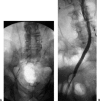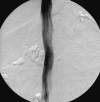Complications of inferior vena caval filters
- PMID: 21326758
- PMCID: PMC3036364
- DOI: 10.1055/s-2006-941445
Complications of inferior vena caval filters
Abstract
Inferior vena caval filters have been shown to be effective in the prevention of pulmonary embolism, with low morbidity and mortality associated with their implantation. Awareness of potential complications can further decrease the risk of filter placement and lead to early detection and management of complications to improve clinical outcomes. The purpose of this article is to review the procedure-related and delayed complications associated with inferior vena caval filters.
Keywords: Inferior vena caval filters; complications; pulmonary embolism; thromboembolic disease.
Figures







References
-
- Bick R L. Hereditary and acquired thrombophilia: preface. Semin Thromb Hemost. 1999;25:251–253. - PubMed
-
- Goldhaber S Z. Pulmonary embolism. N Engl J Med. 1998;339:93–104. - PubMed
-
- Athanasoulis C A, Kaufman J A, Halpern E F, Waltman A C, Geller S C, Fan C. Inferior vena caval filters: review of a 26-year single-center experience. Radiology. 2000;216:54–66. - PubMed
-
- Ferris E J, McCowan T C, Carver D K, McFarland D R. Percutaneous inferior vena caval filters: follow-up of seven designs in 320 patients. Radiology. 1993;188:851–856. - PubMed
-
- Crochet D P, Stora O, Ferry D, et al. Vena-Tech-LGM filter: long-term results of a prospective study. Radiology. 1993;188:857–860. - PubMed
LinkOut - more resources
Full Text Sources
Other Literature Sources

